
ANTIMICROBIAL RESISTANCE:
Antimicrobial resistance (AMR) is the ability of a microorganism (like bacteria, viruses, and some parasites) to stop an antimicrobial (such as antibiotics, antivirals, and antimalarials) from working against it. As a result, standard treatments become ineffective, infections persist, and may spread to others (WHO, 2018).
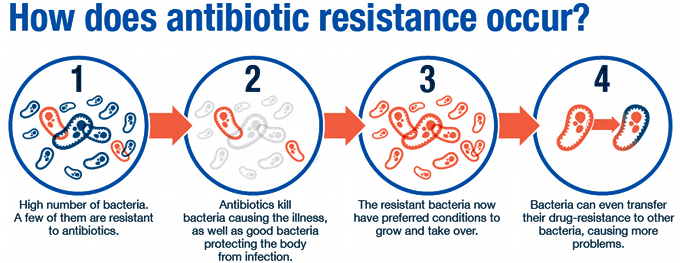
Source: Modernizing Medical Microbiology
Which Came First Antibiotics Or Antibiotic Resistance?
As long as antibiotics have existed, bacterial resistance has existed alongside them — but never on such a large scale. “The natural history of antibiotic resistance genes can be revealed through the phylogenetic reconstruction,” the authors of one study write, “and this kind of analysis suggests the long-term presence of genes conferring resistance to several classes of antibiotics in nature well before the antibiotic era.” In short, bacteria have always been doing what they’re good at finding ways to survive. Genes conferred resistance to several classes of antibiotics in nature – even before the antibiotic era (Lecia Bushak, 2016). The gut bacteria inside 1000-year-old mummies from the Inca Empire are resistant to most of today’s antibiotics like penicillin, vancomycin, and tetracycline (Michael Luongo, 2014). Resistance leads to the emergence of superbugs through the natural selection phenomenon in microbes mostly due to indiscriminate antibiotic prescriptions.
CAUSES OF ANTIMICROBIAL RESISTANCE:
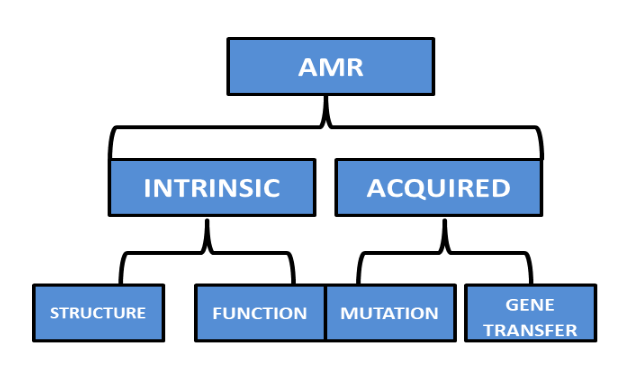
It refers to the innate ability of bacteria to resist the antimicrobial effect of particular antibiotic class through its inherent structural or functional characteristics, viz.
- Resistance found within the genome of the bacterial species (Hollenbeck and Rice, 2012) that is maintained without any antibiotic selective pressure and not induced by other factors. (Cox and Wright, 2013).
- Antibiotic-producing environmental microorganisms show a significant degree of Intrinsic resistance (D’Costa et al., 2011; Cox and Wright, 2013).
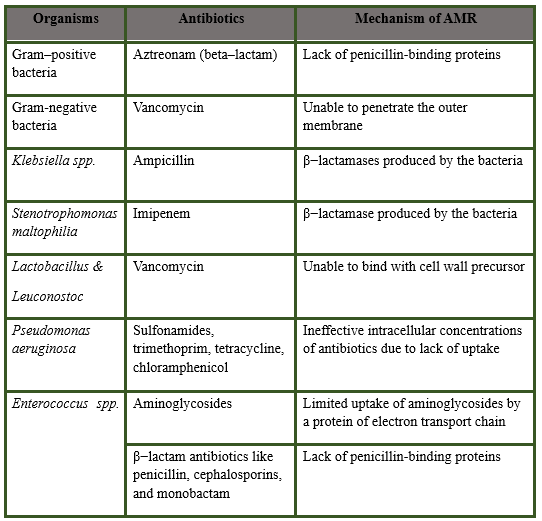
ACQUIRED RESISTANCE:
Bacteria can resist the activity of a particular agent to which it was earlier susceptible. It is mediated by mutation or horizontal gene transfer.
- External antibiotic pressure induce a biological stress on the organism resulting in mutation (Richard Moxon et al.,1998).
- Transfer of mutant gene from the resistant organism to the sensitive organism through horizontal gene transfer will enhance the spread of resistance (Gillings, 2013).
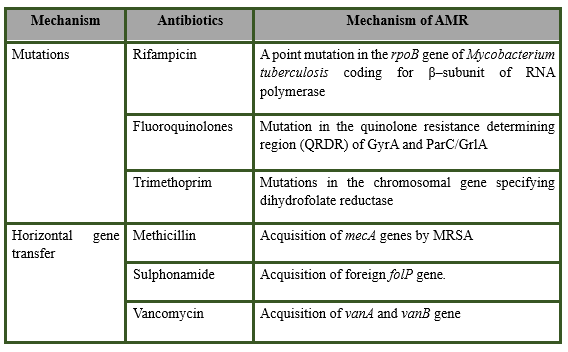
MECHANISM OF AMR:
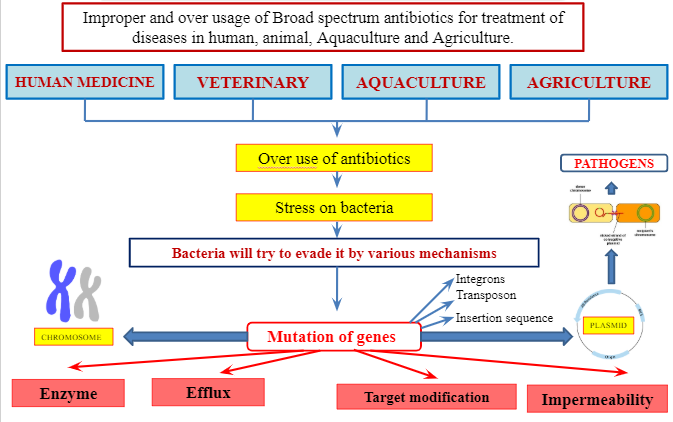
Four major bacterial resistance strategies:
- By preventing the antimicrobial from reaching its target by reducing its ability to penetrate the cell.
Eg. P. aeruginosa – Imipenem, E. aerogenesa & Klebsiella – Imipenem, Gram -ve bacteria – Aminoglycosides , Gram –ve bacteria – Quinolones
- By expulsion of the antimicrobial agents from the cell via general or specific efflux pumps.
Eg. E. coli & Enterobacteriaceae – Tetracyclines, Enterobacteriaceae – Chloramphenicol, Staphylococci-Macrolides , S. aureus & S. pneumoniae –fluoroquinolones
- By inactivation of antimicrobial agents via modification or degradation
Eg. Enterobacteriaceae – Chloramphenicol, Gram -ve & +ve bacteria- Aminoglycosides
- By modification of the antimicrobial target within the bacteria
Eg. S. pneumoniae, Neisseria gonorrheae, Group A streptococci, Listeria monocytogenes– MRSA, E. faecium and E. faecalis – Fluoroquinolones
FACTORS RESPONSIBLE FOR AMR:
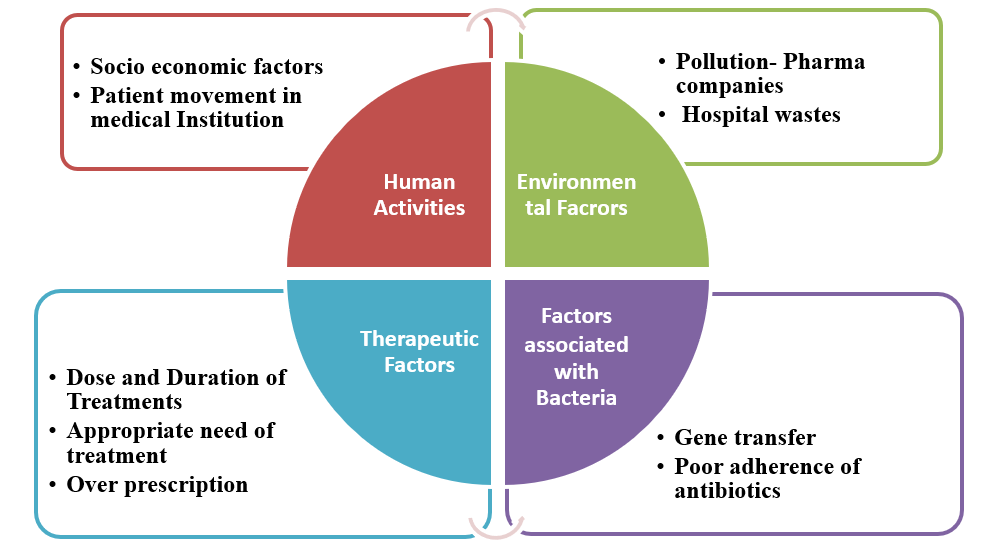
The most common factors responsible for AMR include human activities such as over-usage of antibiotics, improper dosage, intermittent stoppage of the complete course of treatment, over-prescription and inappropriate treatment. Large-scale development of resistance is due to pollution of the environment caused by pharmaceutical industries and hospital wastes.
Timeline of Antimicrobial Resistance:
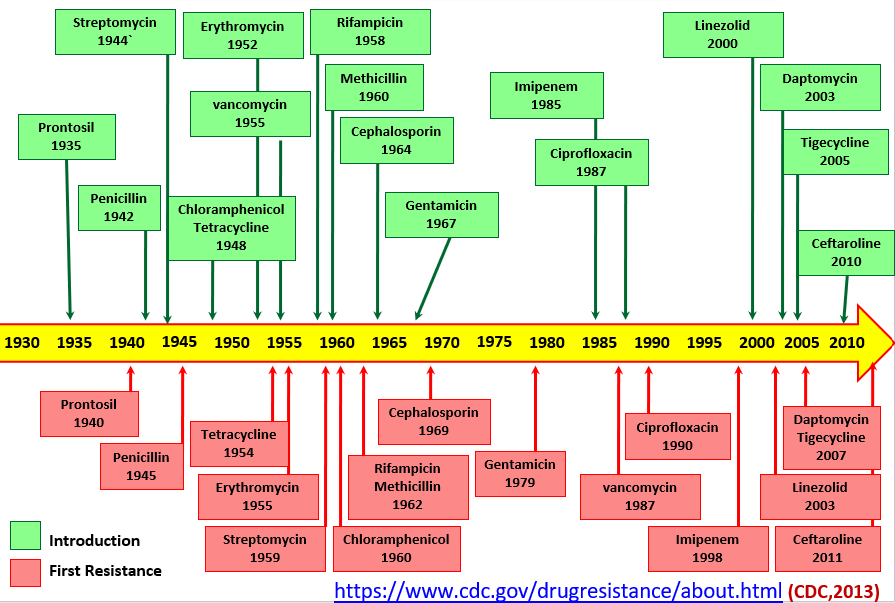
This timeline graph depicts the year of introduction of different antibiotics and the year of identification of the first case of resistance. Even AMR has been reported for the recent drugs like Daptomycin, Tigecycline and Ceftaroline.
Conclusion:
Antimicrobial resistance (AMR) emerged as a global public health problem. Nowadays, multi-drug resistance (MDR) is noticed in most of the common pathogenic organisms of human and animals like E. coli, Salmonella, Staphylococcus, Pseudomonas, etc. The development of new antibiotics or other alternative therapeutics will be the solution for AMR. Now lot of research is going on to develop a novel alternative to antibiotics to counteract resistance. The death rate in neonates and immunocompromised patients due to the infection caused by resistant organisms has increased drastically throughout the world. Prevention is always better than cure; so it is the duty of every individual to use antibiotics judiciously.
References:
- Cox, G. and Wright, G.D., 2013. Intrinsic antibiotic resistance: mechanisms, origins, challenges and solutions. International Journal of Medical Microbiology, 303(6-7), pp.287-292.
- Bushak, L., 2016. A brief history of antibiotic resistance: how a medical miracle turned into the biggest public health danger of our time. Medical Daily.
- Luongo, M., 2014. Fighting Back With Faith: Inside the Yezidis’ Iraqi Temple. The Daily Beast.
- Hollenbeck, B.L. and Rice, L.B., 2012. Intrinsic and acquired resistance mechanisms in enterococcus. Virulence, 3(5), pp.421-569.
- D’Costa, V.M., King, C.E., Kalan, L., Morar, M., Sung, W.W., Schwarz, C., Froese, D., Zazula, G., Calmels, F., Debruyne, R. and Golding, G.B., 2011. Antibiotic resistance is ancient. Nature, 477(7365), pp.457-461.
- Moxon, E.R., Rainey, P.B., Nowak, M.A. and Lenski, R.E., 1998. Adaptive evolution of highly mutable loci in pathogenic bacteria. reproduction, 10, p.14.
- Gillings, M.R., 2013. Evolutionary consequences of antibiotic use for the resistome, mobilome and microbial pangenome. Frontiers in microbiology, 4, p.4.
Citation:
Nishanth Maria Anto Dani Nishanth, Palanichamy Pavithra – Review of Antimicrobial Resistance (AMR). Resource page on Antimicrobial Resistance, The Vet Helpline E-magazine, ISSN 2454-9282 Vol VIII (2020) Available at: http://www.vethelplineindia.co.in/antimicrobial-resistance/


